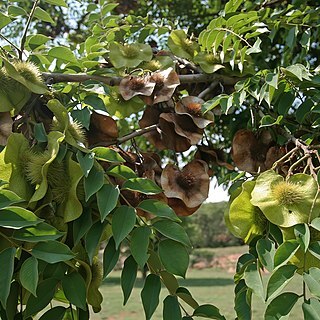Deciduous tree, 5–20(–30) m. tall, with an open spreading crown, rarely (and not in East Africa) a shrub 3–4 m. tall; bark reticulately fissured, rough, greyish-brown to dark grey; slash exuding red sap.. Branchlets brownish or silvery-grey pubescent to floccose-tomentose, tardily glabrescent.. Leaves up to 22–35(–45) cm. long; stipules linear-lanceolate to oblong-elliptic, attenuate, (0.6–)1–2 cm. long, caducous; lateral leaflets (5–)6–9 on either side, broadly lanceolate to elliptic, elliptic-oblong or elliptic-obovate, up to 5–10 cm. long and 3.5–5.5 cm. wide, narrowed to the variously developed but generally short mucronate acumen, rounded to slightly cordate at base, usually hairy on both surfaces but generally soon glabrescent above and sometimes beneath as well, with ± 10–14 fine fairly closely spaced primary lateral nerves and a similar number of well-developed secondary lateral nerves giving a striate appearance; reticulate venation prominulous on both surfaces.. Racemes, or (fide F.C.B.) rarely sparsely branched panicles, precocious or in the axils of young leaves, 6–12 cm. long; axes densely hairy; bracts lanceolate to elliptic-oblong, 5–8 mm. long, caducous; bracteoles near top of the 8–15 mm. long pedicel, linear to linear-lanceolate, 3–8 mm. long, caducous.. Calyx 8–10 mm. long, densely appressed pubescent to tomentose outside but practically glabrous on the lobes inside.. Corolla golden-yellow to orange, 16–20 mm. long; blade of standard suborbicular to oblate with the sides soon folded back in open flowers, marginally crimped; wings broad, exceeding the keel and nearly as long as the standard.. Fruit suborbicular, (8–)10–15 cm. long, with a 1–2.5 cm. long stipe and a broad undulate wing bearing the style basally or basi-laterally, pubescent, also with a mass of long rigid plumose bristles over the central thickened seed-bearing part and smaller ones peripherally, inconspicuously venose.. Fig. 17, p. 90.
A medium sized tree. It grows to 16 m tall. The bark is dark grey. It has cracks along its length. The leaves are made up of 5-9 almost opposite pairs of leaflets and with one at the end. These are 2.5-7 cm long by 2-4.5 cm wide. The lower surface is hairy. They taper to a point at the tip. The base is rounded. The edges are wavy and tightly rolled under. The flowers are orange-yellow and pea-shaped. They occur in large branched sprays. These are 10-20 cm long. The fruit are a circular pod. The seed case is covered with harsh bristles. There is a broad wavy wing around this. This is up to 3 cm wide.
Leaves 18–35 cm long; petiole 2.5–5 cm long, rachis 12–25 cm long, puberulous, glabrescent; petiolules 3–5 mm long; leaflets (4)5–8(9) on each side of the rachis, 3–7 × 2.5–4 cm, ovate to elliptic or subelliptic, obtuse to acuminate-acute at the apex, broadly obtuse or rounded or slightly cordate at the base, light green, glabrous on upper surface, paler appressed-pubescent and glabrescent beneath; lateral primary nerves in 12–18 pairs, secondary ones similar, rather close to each other; stipules 10–18 mm long, linear, caducous.
Seedling (from Fanshawe 1009 (K)): germination epigeal, hypocotyl short; cotyledons 2.5–3.5 × 1.4–1.8 cm. First true leaves simple; stipules 4–5 mm long, puberulous; petiole 8–12 mm long, puberulous; lamina 1.5–3.5 × 1–3.5 cm, elliptic or circular, puberulous on the margin, otherwise glabrous, lateral nerves and reticulation visible on both surfaces.
Standard petal 11–15 mm in diameter, subcircular, emarginate, reflexed-patent, base narrowly decurrent into the c.3.5 mm long claw; wings 11–14 × 5.5–6 mm, broadly obovate, auriculate, claw 3.5–4.5 mm long; keel petals 10.5–12.5 × 3.5 mm, dorsally slightly overlapping and often apparently fused at the overlap, auricle obtuse, claw 5 mm long.
Pod 1(2)-seeded, circular or subcircular, 6.5–13 cm in diameter, wing thin and stiff, undulate, usually asymmetric at the base, densely setose in centre; style-remains bent down to stipe level or overlapping the stipe; pods sometimes replaced by subspherical bristly galls 10–15 mm in diameter.
Inflorescence of lateral racemes borne on new shoots before the leaves, rarely also axillary, fulvous-pubescent, glabrescent; bracts and bracteoles 4–7 mm long, narrowly lanceolate to linear, caducous.
Stamens 10, fused, the tube split to the base on the upper side and variously split on the opposite side to give two groups of 5 stamens, with the upper stamen fused or not with the rest.
Ovary 3–4-ovulate, septate between the ovules, stipitate, densely appressed-pilose; style 4–5 mm long, glabrous towards the tip, stigma small.
Deciduous tree up to 18 m tall; crown rounded or spreading; bark greyish-brown, subquadrangular-fissured, exuding reddish sap when slashed.
Calyx 7–10 mm long, brownish subsericeous; upper teeth c.1.5 mm long, deltoid, others narrowly triangular, acute, 1.5–3.5 mm long.
Flowers 15–18 mm long; pedicels 8–18 mm long.
Young parts greyish or brownish subsericeous.
Seeds oblong-subreniform.


